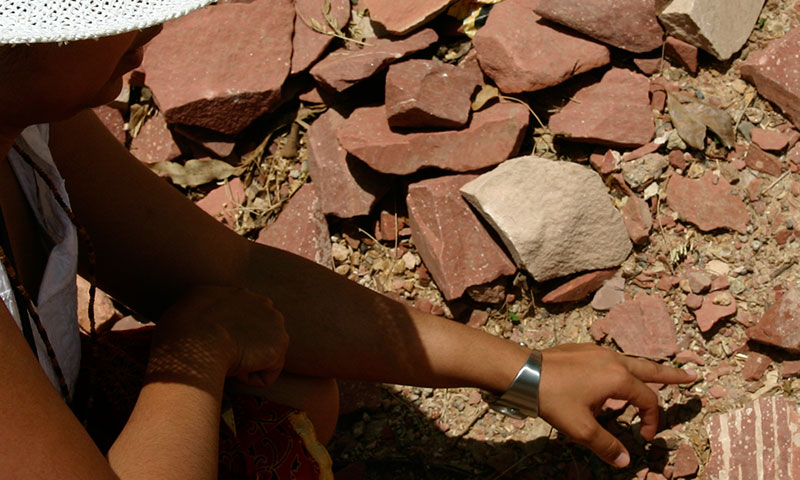What are we fighting for Video
What if, in an instant, one of the world’s most renowned, most beloved, most iconic sites was destroyed? Across the globe, many important cultural heritage monuments face the real threat of ruin by human or natural disaster. Scholars at Notre Dame are helping to ensure the preservation of these treasures.
Architecture professor Krupali Krusche has launched a Digital Historical Architecture Research and Material Analysis (DHARMA) initiative, which is mapping World Heritage Sites like the Taj Mahal and the Roman Forum with unprecedented precision and detail. The digital assessments will be translated into 3-D models which will provide essential information to best preserve and restore these sites in the future.
Professor Krusche’s comprehensive mapping technology and expertise have led her to be recognized as a leading expert on the construction of the Taj Mahal. After earthquakes devastated much of nearby Nepal last spring, authorities called on Professor Krusche to assess the condition of the Taj Mahal and identify any deterioration to ensure the future of the Indian landmark.
In Media
Tim Nelson, Why Removing the Melted Scaffolding from Notre Dame is the Key to its Preservation, Architecture+Design, 23 Jan, 2020.
Michelle Lou and Brandon Griggs, Four years ago, an art historian used lasers to digitally map Notre Dame Cathedral. His work could help save it, CNN, FOX 17 April 2019.
TV and Radio interviews for the fires and destruction of the Notre Dame Cathedral in Paris by NY Times, USA Today, ABC News, CNBC, Washington Post, Herald Mail, Good morning America, Hunter Dunning, WGN9, KTRS, KSRO, WBAL News radio and The Observer.
Notre Dame researchers mapping Vatican City’s Courtyard, ABC57, April 27, 2016.
Geospatial World, Saving the Taj Mahal, Igniting the geospatial revolution, March 8, 2016.
Gorski, Gilbert, and James E. Packer. The Roman Forum: a Reconstruction and Architectural Guide. New York: Cambridge University Press, 2015.
Owen, L., Review on Rediscovering the Hindu Temple, Religious Studies Review, Rice University Press, Volume 41, Issue 1, March 2015, pp. 33–34.
Costanzo, D., What Architecture Means: Connecting Ideas and Design, Routledge, Jul 24, 2015.
Gorski, G., and Packer, J. Architecture of the Roman Forum in the age of the emperors, Cambridge University Press, 2015.
Notre Dame Rome symposium, exhibit to highlight the digital future of world heritage, EurekAlert, AAAS, 28 March 2014.
Sinclair, S., Bibliography of Art and Architecture in the Islamic World (2 Vol. Set), BRILL, Apr 3, 2012.
Stroik, D., The Church Building as a Sacred Place: Beauty, Transcendence, and the Eternal, Liturgy Training Publications, 2012.
Rana, P. “Q&A: How Safe is the Taj Mahal?” The Wall Street Journal, Oct 28, 2011, India Realtime, (republished by Big Think, Geospatial World).
Mario Santana Quintero, Ona Vileikis, Change Over Time, Volume 1, Number 2, Fall 2011, pp. 156-164.
Howard Kunstler, J. What We Can Learn from Transylvania, The Kunstler Cast: Conversations with James Howard Kunstler, Oct 12, 2010.
Kuntz, T. Transylvania: Green, Not Blood-Red, The New York Times, October 8, 2010, Idea of the day, (republished by World News Network, Business Week).
John, R. University of Notre Dame, Design VI, Fourth Year Undergraduate Studio, The Classicist, No.8, From the Academics, Spring 2009.
Brussat, D. “Parsing the Classical Temples of India,” Providence Journal, Sep 13, 2009, Architecture Here and There.
Mhatre, K. “The Mumbai Mills and INTBAU-India: An inquiry by design,” Indian Architect and Builder, Jasubhai Media, July 2005, Vol 18 (11).
The International Committee for the Conservation of the Industrial Heritage, “Revitalisation of Mumbai Mills,” Number 29, Spring 2005.
Bowman, C. “Building Character in El Cerrito: Visiting architects are trying to give the city a sense of place,” San Francisco Chronicle, August 8, 1997, Chronicle East Bay Bureau.
